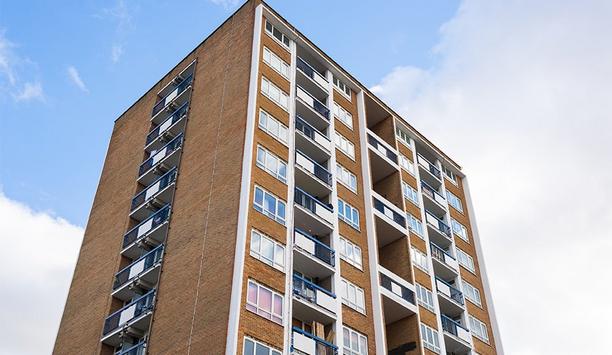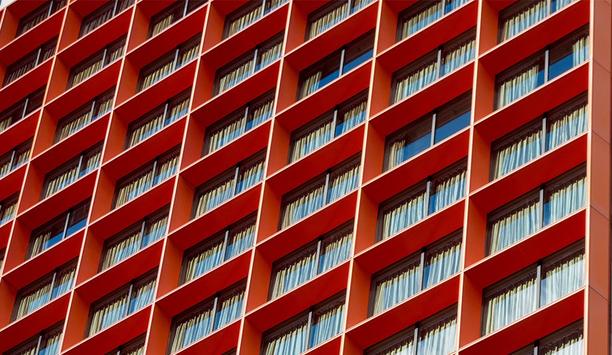Since the Grenfell tower tragedy in 2017, residential high-rise fire safety has become a top priority for tower block building managers. If a high-rise building is found to contain combustible cladding, then the standard ‘stay put’ policy is no longer considered safe, and instead a temporary ‘simultaneous evacuation’ strategy must be put in place until the cladding issue is resolved.
Currently a Waking Watch protocol is the preferred option for ensuring resident’s safety, in order to coordinate a simultaneous evacuation in the event of a fire. But, due to the extremely high cost of Waking Watch, Fire Detection & Alarm systems are being used to help reduce and, in some cases, remove these costs, which can amount to upwards of £100,000 per year.
After the Grenfell fire, official figures showed that there are 300 towers with ‘Grenfell-style’ Aluminum Composite Material (ACM) cladding. However, there are many different types of high-risk flammable cladding used on purpose-built blocks of flats, such as timber, high-pressure laminate (HPL) and polystyrene cladding. With more and more unsafe buildings being assessed, the scale of this issue continues to grow.
Currently a Waking Watch protocol is the preferred option for ensuring resident’s safety
The UK Government announced in 2018 that it would pay for the removal and replacement of unsafe cladding in councils and housing associations. However, there is no legal position stating that private landlords should not pass the cost of this work onto tenants, and with the high costs of replacement, along with mounting Waking Watch costs, private landlords are known to pass this cost to tenants in service charges.
Along with the cost of cladding replacement, landlords are also charging tenants for the cost of expensive Waking Watch services. Approved fire alarm systems are fast becoming the preferred safety system, due to the reduced overall costs, as well as the NFCC (National Fire Chiefs Council) recommending these over Waking Watch services.
Fire safety regulations in high-rise buildings
Following the Grenfell tragedy, the Government issued notice that all buildings over 18m had to be assessed for combustible material in their external walls. Following this, in January 2020, the government also issued Advice for Building Owners of Multi-story,
Multi-occupied residential buildings stating that “building owners are to consider the risks of any external wall system and fire doors in their fire risk assessments, irrespective of the height of the building” immediately, until a Fire Safety Bill is put in place.
Approved fire alarm systems are fast becoming the preferred safety system
In order to assess the fire risk of external wall systems of residential apartment buildings an EWS1 assessment (External Wall Fire Review) must be completed. This risk assessment form provides a ‘safe’ or ‘unsafe’ certificate for the building, and must be completed by a competent fire expert. Not only does an ‘unsafe’ certificate affect the owner of the building, with the need for new fire safety solutions, it also directly affects tenants, with mortgage lenders refusing to lend on a apartment until they are satisfied that the facade is safe.
Until the building has completed the assessment and been deemed safe, all dwellings within the building are valued at £0, and cannot be sold.
'Unsafe' certificates
Buildings that have been awarded an ‘unsafe’ certificate through the EWS1 assessment will need to implement temporary fire safety measures while the cladding is being removed. The key purposes of this guidance, outlined by National Fire Chiefs Council (NFCC) in May 2018 and then reviewed in October 2020, are: early detection of a fire, warning of building occupants, and management of the evacuation. The measures state:
- In order to prevent tenants from being removed from their homes, ‘Stay Put’ must be temporarily replaced by a ‘Simultaneous Evacuation’ strategy until the building has been remediated.
- Temporary protection measures must be introduced to ensure the safety of residents; either a 24/7 Waking Watch or a common Fire Detection & Alarm system designed to BS5839 Part 1 category L5 specification.
Fire safety solutions
Waking Watch is the quickest and easiest way to fulfill the requirements from the NFCC guidance. This solution requires a trained fire marshal or warden to patrol the building 24/7 and alert residents in the case of a fire. They will also be responsible for carrying out the Simultaneous Evacuation strategy and assisting residents’ evacuation.
While the Waking Watch solution works well as an immediate solution to fire safety, the mounting costs of this fix means that it is unsustainable in most situations, with tenants facing unaffordable increases to their monthly rent in order to cover the costs. For example, reports into Raphael House, near Essex, show how a five-person 24-hour patrol costs £50,000 per month. This cost is split between the 154 flats, resulting in average costs of more than £300 a month for each resident.
Issues with Waking Watch
In addition to the cost, there are other issues associated with Waking Watch, including:
- Patrols cannot cover all areas of the building at all times
- No fire detection system within the flats themselves
- Not a long term solution
The alternative solution to fire safety in high-rise buildings, as per the NFCC guidance, is to install a Fire Detection & Alarm system designed to BS5839 Part 1 category L5 specification. Although the upfront cost of these systems tend to be higher than a Waking Watch initiative, the overall expenditure, given the cost and time it takes to replace the cladding, far exceeds the cost of a fire alarm system.
NFCC compliant fire alarm systems
An NFCC compliant fire alarm system ensures early detection of fire and alert to residents. The BS5839 Part 1 category L5 systems do not replace the mains wired smoke alarms required in each apartment, but instead are installed in the common areas of the building in order to provide additional cover for these communal areas. These fire systems should be:
- Designed in accordance with BS5839, Part 1, category L5
- Heat detectors should be installed throughout the building next to the windows that overlook an area of the external wall, including within the dwellings.
- An immediate evacuation signal should be triggered by the operation of any single heat detector.
- Installation of a new common area fire alarm system should not cause any further damage to the compartmentation or have an adverse effect on other provisions in the building.
Comparison (Waking Watch vs Fire Alarm Systems)
- Cost: The government has outlined the average cost of Waking Watch in England as £17,897 per building per month, with the hourly rate per person undertaking Waking Watch duties ranging from £12.00 to £30.00 per hour. A total of £644,292 over 3 years. Additional charges for equipment, facilities, accommodation and services can also be applied. A suitable fire alarm system is likely to cost around £65,000 over the course of 3 years, for installation and yearly recurring costs. This means, over this period, installing a fire alarm system will save a total of £579,292.
- Long term solution: While both Waking Watch and a Fire Alarm System are considered short term solutions, many fire alarm systems can be adapted for future use once the cladding issue has been resolved, providing suitable infrastructure is created at the design and installation stage.
- Alerting the whole building at once: A Fire Alarm System is a more time efficient solution to detecting a fire than Waking Watch. The system is able to alert the whole building at the same time, allowing for the simultaneous evacuation protocol to be followed in a more time efficient manner.
The NFCC states in their Simultaneous Evacuation Guidance...
“NFCC strongly recommends that where a change to a simultaneous evacuation is deemed appropriate and will be required for medium to long periods of time that a temporary common fire alarm system is installed. This is because a temporary common fire alarm, when designed, installed and maintained appropriately is a more reliable and cost-effective way to maintain a sufficient level of early detection. An appropriate communal fire alarm and detection system will generally provide more certainty that a fire will be detected and warned at the earliest opportunity rather than rely on using trained staff.”
With many residential high-rise buildings needing additional protection due to flammable cladding, and the excessive cost of Waking Watch, now is the time to consider a Fire Alarm System to keep residents in high-rise buildings safe.


















